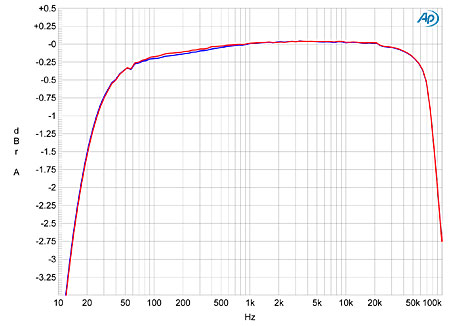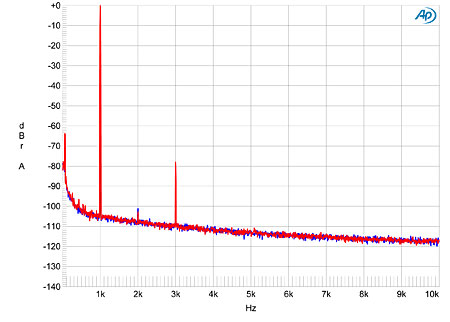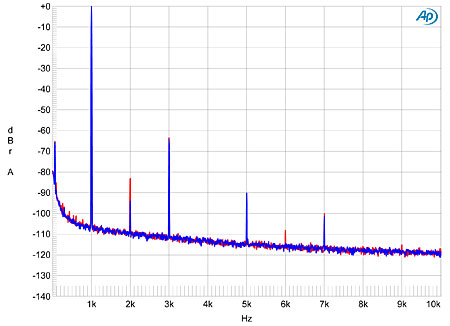| Columns Retired Columns & Blogs |
Vitus Audio MP-P201 Masterpiece Series phono preamplifier Measurements
Sidebar 2: Measurements
I measured the Vitus MP-P201 (serial nos.: VA090097, power supply; VA090096, preamplifier) with Stereophile's loan sample of the Audio Precision SYS2722 system (see the January 2008 "As We See It" and www.ap.com). The Vitus's front-panel pushbuttons offer 14 choices of voltage gain for both its balanced and single-ended inputs, ranging from 86dB at "125µV" to 46dB at "10mV." The measured gains were the same for both inputs, and were all about 10dB higher than usual for the nominal cartridge sensitivity. For example, setting the sensitivity to "5mV," which is the typical output of a moving-magnet cartridge, gave a measured gain of 52.4dB compared to the usual 40dB or so. As the chosen sensitivity affects both the level of background noise and the overload margin, I recommend that Vitus owners—one of whom, apparently, is Russia's president, Dmitry Medvedev—set the preamplifier sensitivity, hence gain, two steps lower than the nominal value; eg, for a moving-coil cartridge with a nominal output of 500µV at a recorded velocity of 5cm/s, set the MP-P201's sensitivity to "900µV."
The Vitus MP-P201 preserved absolute polarity (ie, was non-inverting) through both inputs. The XLR jacks appear to be wired with pin 2 hot. The input impedance is selected with front-panel pushbuttons, with 18 choices available. The nominal values depend on the sensitivity setting, and range from 100 to 2000 ohms for sensitivities from "125µV" to "900µV," and from 105 to 47k ohms for sensitivities from "1.3mV" to "10mV." The measured input impedance at low and midrange frequencies was slightly but inconsequentially higher than the nominal value. For example, set to "168 ohms," the actual input impedance was 174 ohms; set to "1000 ohms," it was 1011 ohms. At 20kHz, all the input impedances were a little higher still, but this should have no audible consequences. The MP-P201's output impedance was low at high and midrange frequencies, at 118 ohms, rising slightly but inconsequentially to 128 ohms in the low bass.
The error in the preamplifier's RIAA correction was very low (fig.1), with superb channel matching. The response was sensibly curtailed above the audioband, reaching –3dB at 100kHz, while at low frequencies, the Vitus incorporates the IEC infrasonic rolloff, reaching –3dB at 13Hz. Channel separation (not shown) was better than 90dB across the band, though actual crosstalk was buried under the preamp's noise floor. With the sensitivity set to "10mV," the wideband, unweighted signal/noise ratio, measured with the input shorted, was 51.7dB ref. 1kHz at 5mV, which improved to 53.6dB when the measurement bandwidth was restricted to the audioband, and to 62.8dB when A-weighted. These figures are maintained at other sensitivity settings, allowing for the additional gain compared with the "10mV" setting—but the Vitus is not as deathly quiet as the Boulder 1008, which offered unweighted, audioband S/N ratios of 76.5dB (MM, ref. 1kHz input at 5mV) and 60dB (MC, ref. 1kHz at 500µV).

Fig.1 Vitus Audio MP-P201, RIAA response (0.25dB/vertical div.).
At low and midrange frequencies, the Vitus's overload margin basically correlated with an output level of close to 13V RMS. Thus, the greater degree of gain selected, the lower the output margin referred to a fixed level at 1kHz. And thus, with "10mV" selected, the overload margins at 20Hz and 1kHz, ref. 5mV at 1kHz with 1% THD, were a good 24 and 22dB, respectively. With the sensitivity set to "1.3mV," however, these respective margins, ref. the same 5mV level, decreased to 7 and 4.6dB, reinforcing the importance of setting the MP-P201's sensitivity a couple of settings lower than the nominal one for a particular cartridge. Overload at low and midrange frequencies was associated with the usual clipping of the waveform tops and bottoms. At high frequencies, however, overload occurred because the waveform began to triangulate, presumably due to slew-rate limiting somewhere in the circuit. The 1% limit was reached around 7V output, which gave a reduced margin at 20kHz compared with lower frequencies, though the margin was still good enough.
At normal levels into a high impedance, the distortion was almost entirely the third harmonic (fig.2), which will be subjectively innocuous even at levels greater than the MP-P201's –79dB (0.011%). With the demanding 600 ohm load, the third harmonic rose to –64dB (0.06%), and was joined by the second, fifth, sixth, and seventh harmonics, with the right channel being slightly less linear than the left (fig.3). However, the nonlinearities are still low enough to be inaudible. The Vitus performed relatively well on the high-frequency modulation test, all the spuriae from the demanding mix of 19 and 20kHz tones remaining below –72dB (not shown).

Fig.2 Vitus Audio MP-P201, spectrum of 1kHz sinewave, DC–10kHz, at 2V into 100k ohms (left channel blue, right red; linear frequency scale).

Fig.3 Vitus Audio MP-P201, spectrum of 1kHz sinewave, DC–10kHz, at 2V into 600 ohms (left channel blue, right red; linear frequency scale).
This massive, beautifully built, two-box phono preamplifier offers almost unrivaled versatility, excellent channel matching, and almost zero RIAA error, but is not as quiet as I would have wished so expensive a product to be. Unfortunately, while the Vitus MP-P201 Masterpiece is well engineered, there is nothing in its measured performance that would indicate why Michael Fremer was so taken by its sound quality.—John Atkinson
- Log in or register to post comments




































